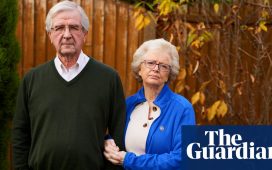Two Russian agents suspected of carrying out the Salisbury nerve agent poisoning may have used a portable heat sealer to repackage a fake perfume bottle containing novichok during a “missing 33 minutes” when they vanished from CCTV cameras shortly after the attack, an inquiry heard.
The police counter-terrorism chief who leads the investigation said it was possible they slipped into a toilet block, re-sealed the novichok container in plastic and left it in a bin in the city centre before re-appearing on security cameras.
Commander Dominic Murphy, the head of the Met police’s counter-terrorism command, revealed the pair may have been handed the novichok by a third man in London before they travelled to Salisbury.
He also spelled out a precise time window for when he believes the agents applied novichok to the door of their target, former Russian spy Sergei Skripal – between noon and 12.15pm on Sunday 4 March 2018.
The inquiry in London is examining the lead-up to the death of Wiltshire woman Dawn Sturgess, 44, who was poisoned in June 2018 after her partner, Charlie Rowley, found a fake perfume bottle containing novichok. Rowley has said he came across the bottle in a charity shop bin in Salisbury.
Murphy said the two agents who allegedly carried out the attack went by the names Alexander Petrov and Ruslan Boshirov and were members of Russian military intelligence unit 29155. The third man was known as Sergey Fedotov.
All three arrived in the UK on 2 March 2018, Murphy said. Petrov and Boshirov stayed in a hotel in Bow, east London, while Fedotov took a room in Paddington, central London.
Murphy said that, just before Petrov and Boshirov made a train trip to Salisbury on 3 March for what he believes was a reconnaissance mission, phone analysis seems to show the three met near Waterloo station in London. They also appeared to rendezvous in the Bond Street area of the city after Petrov and Boshirov returned from Salisbury that evening.
Murphy said his assessment was that Fedotov was “some kind of coordinator or at least support mechanism” to Petrov and Boshirov.
He was asked it if was possible that at one of the meetings Fedotov handed over novichok to the two. Murphy replied: “That is entirely possible.”
On Sunday 4 March, Petrov and Boshirov again travelled by train to Salisbury. CCTV cameras caught them heading towards the street where Skripal lived but there is a 15-minute gap in coverage between noon and 12.15pm.
A summary of the police’s conclusions reads: “Counter Terrorism Police assesses that the suspects must have deposited the novichok on Sergei Skripal’s front door handle during the 15-minute gap in CCTV coverage between 12 and 12.15. Sergei and Yulia Skripal were still inside at that time.”
The two agents walked back towards the city centre but again disappeared from CCTV for 33 minutes between 12.31pm and 1.04pm. When they came back into view, Petrov was carrying a rucksack that previously Boshirov had on his back.
Murphy said it was “entirely possible” the pair paused in a toilet block where traces of novichok were later found. He was asked by the counsel for the inquiry, Andrew O’Connor, if it would have been possible for them to use a heat sealer to repackage the novichok container and then get to the car park where Rowley says he found it. He said: “It would be challenging but entirely possible they could do that in 33 minutes.”
However, Murphy also conceded the bottle found by Rowley, which was sealed in plastic packaging, may have been a second container. He said: “I have a strong assessment this is the same novichok but I don’t think we can ever discount the fact there may have been another.”
The inquiry continues.











